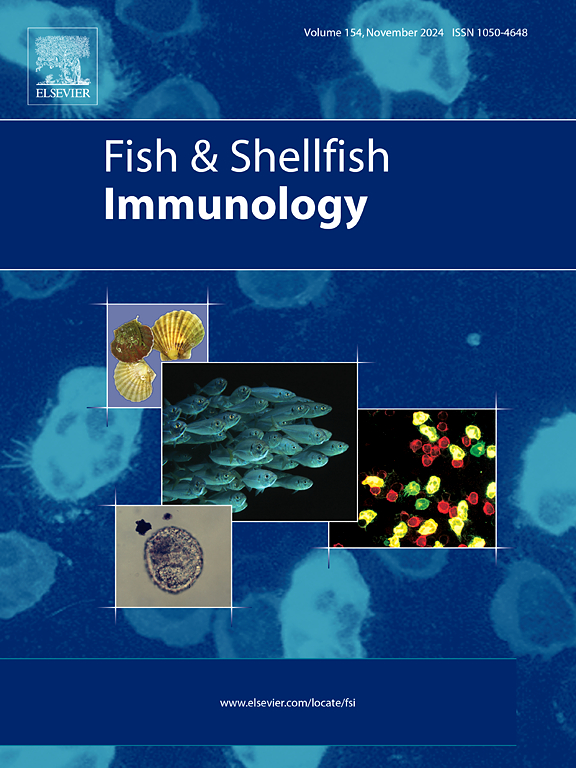转录组学分析揭示了长棘棘对无乳链球菌感染的免疫反应机制。
IF 4.1
2区 农林科学
Q1 FISHERIES
引用次数: 0
摘要
黄鳍棘鱼(Acanthopagrus latus)是中国东南沿海重要的经济鱼类。其生长速度较慢,使其在栽培期间更容易发生病害,造成重大经济损失。流行病学调查表明,无乳链球菌是最常见的革兰氏阳性病原体之一,由于其在拉氏弧菌中的高传染性和致死率而引起越来越多的关注。本文通过腹腔注射无乳链球菌建立了黄鳍鱼感染模型。为揭示无乳链球菌感染对黄鳍鲷的影响及免疫应答机制,对临床体征明显的组织(肝、肠)进行组织学检查、血清生化指标评估、免疫相关酶水平测定、转录组分析等临床体征观察和分析。结果表明,感染鱼出现明显的临床症状和多组织损伤,各项指标发生显著变化,血清中免疫相关酶水平显著升高。RNA测序分析发现,肝脏中有1130个差异表达基因(deg),肠道中有1218个差异表达基因(deg),通过KEGG富集分析,这些差异表达基因参与多种免疫和代谢相关途径。一些特异性免疫相关基因的实时定量RT-PCR (qRT-PCR)检测进一步证实了转录组学结果。这些发现为黄鳍鱼感染无乳链球菌后的分子免疫机制提供了新的认识,并为疾病预防和分子育种(即通过开发关键基因的分子标记进行选择性育种)提供了有价值的参考数据。本文章由计算机程序翻译,如有差异,请以英文原文为准。

Mechanisms of immune responses in Acanthopagrus latus to Streptococcus agalactiae infection revealed by transcriptomic analysis
Acanthopagrus latus (yellowfin seabream) is an economically important fish in the southeast coastal sea of China. Its slower growth rate makes it more prone to diseases in the cultivation period, leading to substantial economic losses. Epidemiological investigations have indicated that Streptococcus agalactiae is one of the most common Gram-positive pathogens, which have garnered increasing attention due to its high contagion and lethality rates in A. latus. In this work, an infection model of yellowfin seabream was established with an intraperitoneal injection of S. agalactiae. Clinical sign observations and various analyses, including histological examination, serum biochemical index assessment, immune-related enzyme level measurement, and transcriptome analysis of tissues (liver and intestine) with obvious clinical signs, were conducted for revealing the effects of S. agalactiae infection and immune response mechanisms in yellowfin seabream. The results indicate that evident clinical signs and multi-tissue damages with the notable changes in indices and significant increase in immune-related enzyme levels in the serum occurred in infected fish. RNA sequencing analysis identified 1130 differentially expressed genes (DEGs) in the liver and 1218 DEGs in the intestine, which were involved in multiple immune- and metabolism-related pathways via KEGG enrichment analysis. The transcriptomic results were further corroborated by quantitative real-time RT-PCR (qRT-PCR) tests of some specific immune-related genes. These findings provide new insights into the molecular immune mechanisms in yellowfin seabream following S. agalactiae infection and offer valuable reference data for disease prevention and molecular breeding (i.e., selective breeding through developing molecular markers of key genes).
求助全文
通过发布文献求助,成功后即可免费获取论文全文。
去求助
来源期刊

Fish & shellfish immunology
农林科学-海洋与淡水生物学
CiteScore
7.50
自引率
19.10%
发文量
750
审稿时长
68 days
期刊介绍:
Fish and Shellfish Immunology rapidly publishes high-quality, peer-refereed contributions in the expanding fields of fish and shellfish immunology. It presents studies on the basic mechanisms of both the specific and non-specific defense systems, the cells, tissues, and humoral factors involved, their dependence on environmental and intrinsic factors, response to pathogens, response to vaccination, and applied studies on the development of specific vaccines for use in the aquaculture industry.
 求助内容:
求助内容: 应助结果提醒方式:
应助结果提醒方式:


